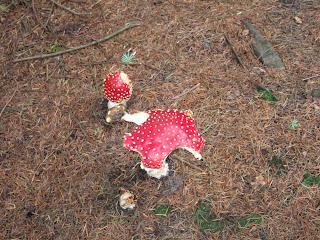end up from Wales . Craster village has many attractions: you can examine the small painted boats beached in the tiny harbou
r, buy kippers from the smokehouse or drink a pint at the nice pub overlooking the sea, but the real draw is the 1/2 mile walk to Dunstanburgh castle. Craster in fact boasts everything but solitude. So many people were doing this walk that taking a photo of the castle without them proved impossible.
The area called the Heughs to the north of the village overlooks some inlets with sloping beds of whin sill on the coast, and mesolithic flint tools have been found here. Whin refers to the rocks themselves, made of volcanic dolomite, which were forced through layers of older rock by movement of the earth's tectonic plates, so that the Whin Sill (sill being the horizontal body of rock) always looks as if it's surprised to be amongst all the smooth land or rocks roundabout.
The castle before us was immense, its ruins a stark reminder of harder times when men needed the protection of great stone buildings. Built by the great Earl of Lancaster from 1313 -16 as a safe haven from his enemy Edward II, it never served its purpose. Lancaster was captured after a failed rebellion and beheaded, having only fled as far as Boroughbridge in Yorkshire.
Whin sill inlet, the Heughs

Once we were past the castle the crowds melted away. We wondered why
no-one else was on the beach, until we were obliged to take off our boots to ford a cold stream carving a deep unavoidable channel in the sand near Em bleton village! Looking back the cliffs north-east of the castle showed the signs of summer residency to nesting seabirds, all now flown.
bleton village! Looking back the cliffs north-east of the castle showed the signs of summer residency to nesting seabirds, all now flown.
 bleton village! Looking back the cliffs north-east of the castle showed the signs of summer residency to nesting seabirds, all now flown.
bleton village! Looking back the cliffs north-east of the castle showed the signs of summer residency to nesting seabirds, all now flown. Dunstanburgh from the North
Leaving Embleton bay, the path continued round a headland to Newton Pools nature reserve, and in the bird hide with its view of wildfowl, in particular shoveler ducks, on the pool we enjoyed a restful interlude in a fairly demanding day. Afterwards we wandered down to Low Newton by the Sea, and patronised the trendy pub enclosed on three sides by a courtyard of pretty cottages next to the beach.

Newton Links and beach
The beach north of Low Newton, fringed by Newton Links nature reserve, is isolated and beautiful, with marram grass dunes edging the beach. It is also a long way! As we edged towards Beadnell large lesser black-backed gulls stood out from the smaller birds in a large flock of gulls feeding at the water's edge. We forded another stream then wandered tiredly into Beadnell, admiring the lobster pots and lime kiln round the harbour. Thanks to Rob as ever for his company, encouragement and car!

Lesser black-backed and common gulls on the beach south of Beadnell.























